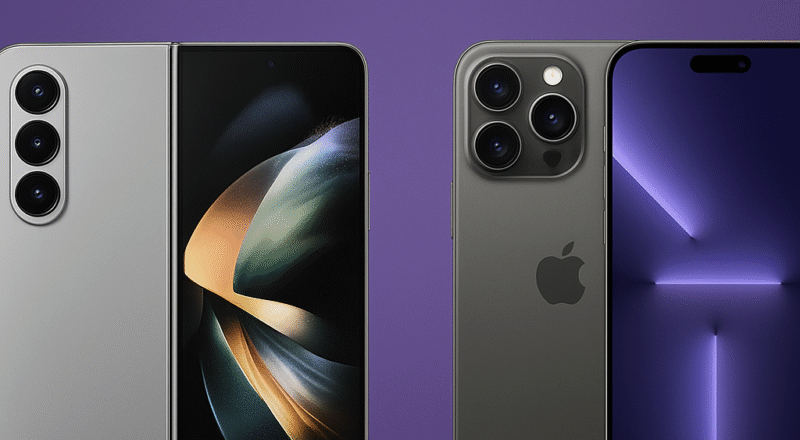Introduction
The smartphone industry has always thrived on rivalries. In the 2010s, it was Apple vs. Samsung in the traditional flagship market. In the 2020s, however, the battle has shifted: foldables are no longer experimental gadgets — they’re increasingly mainstream. And in 2025, the Samsung Galaxy Z Fold 7 and iPhone 16 Pro Max represent two very different visions of the future of mobile computing.
While Apple doubles down on perfecting the “slab” design, Samsung is betting that foldables are the inevitable next step. So which one truly deserves the American consumer’s pocket — and the $1,500+ price tag that comes with it?
Design and Build
Samsung has refined its foldable formula for years, and the Galaxy Z Fold 7 is the sleekest yet. At just 11mm when folded, it feels less like a sci-fi prototype and more like a premium flagship. Its hinge system, lighter titanium build, and dust resistance (finally!) put it leagues ahead of older foldables.
The iPhone 16 Pro Max, by contrast, isn’t revolutionary — but Apple’s attention to detail is unmatched. The titanium edges, ultra-thin bezels, and slightly slimmer body compared to the iPhone 15 Pro Max make it the most refined slab phone Apple has ever made.
Verdict: If you want futuristic design, Samsung wins. If you want perfection in a familiar form, Apple still leads.
Display Technology
-
Galaxy Z Fold 7:
-
7.8-inch QHD+ AMOLED inner display, 120Hz adaptive refresh
-
6.3-inch outer display, brighter and less cramped than its predecessor
-
Peak brightness: 2,800 nits
-
-
iPhone 16 Pro Max:
-
6.9-inch LTPO OLED ProMotion display, 120Hz adaptive refresh
-
New Ultra Retina XDR tech with improved HDR and outdoor visibility
-
Peak brightness: 2,600 nits
-
Apple’s display tuning remains industry-leading for color accuracy, but Samsung’s inner foldable screen essentially gives you a tablet in your pocket. For multitasking, media consumption, and productivity, Samsung takes the crown.
Verdict: Foldable versatility (Samsung) vs. perfected flat panel (Apple).
Performance and AI Features
Both flagships are powered by custom 3nm chips:
-
Galaxy Z Fold 7 → Snapdragon 8 Gen 4 for Galaxy, tuned for Samsung AI tasks.
-
iPhone 16 Pro Max → A18 Pro Bionic, tightly integrated with Apple Intelligence.
The real battle is AI:
-
Apple Intelligence → System-wide integration across iOS, including smart summaries, generative image editing, contextual Siri 2.0, and privacy-first AI with on-device + cloud hybrid processing.
-
Galaxy AI → Real-time translation, generative wallpapers, transcript summarization, multitasking enhancements, and productivity features designed for the foldable experience.
Apple’s AI feels more polished and deeply woven into apps, but Samsung’s foldable format makes its AI tools more practical for multitasking.
Verdict: Tie — Apple wins on polish, Samsung wins on use cases.
Cameras
-
iPhone 16 Pro Max:
-
Triple-lens system: 48MP main, 48MP ultrawide, 12MP 5x telephoto (exclusive to Pro Max)
-
Improved computational photography for low-light and video
-
Dolby Vision video still unmatched
-
-
Galaxy Z Fold 7:
-
Triple-lens system: 50MP main, 12MP ultrawide, 12MP telephoto (3x optical)
-
Under-display inner selfie camera (improved but still weaker than Apple’s front camera)
-
Advanced AI editing baked into Gallery app
-
Apple continues to dominate video quality and consistency, while Samsung’s camera setup is good but doesn’t challenge Apple at the high end.
Verdict: iPhone 16 Pro Max.
Battery Life and Charging
-
iPhone 16 Pro Max:
-
4,800mAh equivalent battery
-
Up to 30 hours video playback
-
MagSafe ecosystem still thriving
-
30W wired, 20W wireless
-
-
Galaxy Z Fold 7:
-
5,000mAh dual-cell battery
-
Larger inner screen drains faster under heavy multitasking
-
45W wired, 25W wireless
-
Reverse wireless charging for earbuds/wearables
-
Samsung charges faster and supports reverse wireless charging, but Apple’s efficiency and battery endurance are still best in class.
Verdict: Apple wins on endurance, Samsung wins on flexibility.
Price and U.S. Market Availability
-
Galaxy Z Fold 7 → $1,899 starting price, available unlocked and through major U.S. carriers with aggressive trade-in deals.
-
iPhone 16 Pro Max → $1,299 starting price, with Apple’s ecosystem, carrier bundles, and financing options.
While Samsung offers innovation, Apple’s pricing is more accessible. In the U.S., where carrier subsidies and trade-ins are popular, Apple holds the edge for mass adoption.
Consumer Trends in the U.S.
According to Counterpoint Research (Q1 2025):
-
Foldables made up just 5% of U.S. smartphone sales.
-
Apple still commands over 50% of the U.S. premium market.
This shows that while Samsung is pioneering, Apple still dominates American consumer habits.
Future Outlook
-
If Samsung can bring foldable prices closer to slab flagships, adoption could accelerate in the U.S.
-
Apple is rumored to be working on a foldable iPad/Mac hybrid instead of a foldable iPhone, meaning Samsung may have years of uncontested dominance in foldables.
-
For now, the iPhone 16 Pro Max is the safer, more mainstream buy, while the Galaxy Z Fold 7 is for early adopters who want the future now.
Final Verdict
-
Design & Display: Samsung
-
Performance & AI: Tie
-
Cameras: Apple
-
Battery & Charging: Tie (Apple endurance, Samsung flexibility)
-
Price & Availability: Apple
👉 If you want the best overall U.S. flagship in 2025, the iPhone 16 Pro Max is still king.
👉 If you want the most futuristic and innovative smartphone, the Galaxy Z Fold 7 is unmatched.
Both are incredible — but they reflect two very different visions of mobile computing.
